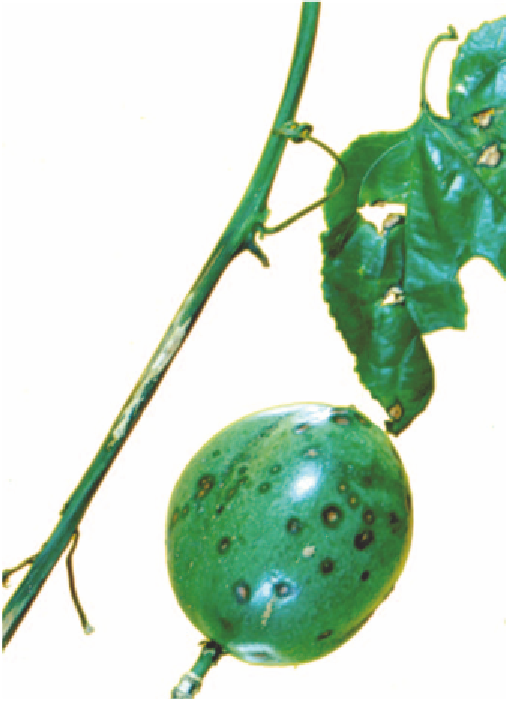Agriculture Reference
In-Depth Information
Maintain vine health and vigour.
•
Fruit: light brown, circular, sunken spots develop that
wrinkle while enlarging and may cover one side of the
fruit.
If young vines become infected, mulch around their base
to encourage adventitious root development above the
damage.
•
Granadilla (
Passif lora quadrangularis
) shows similar
symptoms.
Avoid damage to the stems of vines as this may provide
an entry point for the fungus.
•
Source of infection and spread
Spores, produced on leaf, stem and fruit spots, are
blown by wind and rain to adjacent vines. Warm, moist
weather favours disease development. Susceptible
species of wild passion f lowers, particularly white
passion f lower (
Passiflora subpeltata
) and stinking
passion f lower (
Passif lora foetida
), may be a source of
inoculum.
BROWN SPOT
■
Cause
The fungus
Alternaria passiflorae
.
Symptoms
Leaves: large spots up to 10 mm wide develop, at first
chestnut-brown in colour, fading to lighter shades of
brown. Spots often extend along the main veins.
Importance
In eastern Australia, brown spot is generally less common
in hybrids than
Alternata
spot, but can still cause
significant losses.
Stems: symptoms usually occur near leaf axils where
brown spots up to 30 mm in length develop. Stems may
eventually be cinctured at these points, causing death
of large sections of vines.
Management
•
Eradicate alternative hosts growing nearby.
Spray with recommended protectant and curative
fungicides.
•
Prune vines to reduce density and allow better spray
penetration.
•
Plant varieties with resistance to the disease.
•
FUSARIUM WILT
■
Cause
The fungus
Fusarium oxysporum
f. sp.
passiflorae
.
Symptoms
The disease is first noticed as a wilting of one or more
shoots and is often followed by total collapse and death of
the plant. Immature fruit shrivel and remain attached to
the vine. If an infected stem is examined, the water-
conducting tissues will be discoloured brown or reddish-
brown. This vascular browning may extend the entire
length of the vine.
Source of infection and spread
The fungus is a soil inhabitant and may survive for many
years as dormant resting spores. Infection occurs through
the roots below the soil line and moves to the water-
conducting tissues of plant roots.
Fig 15.8 Brown spot affecting leaves, stems and fruit in passionfruit.












